Recent Articles
Popular Makes
Body Types
2015 Lincoln MKC First Drive Review
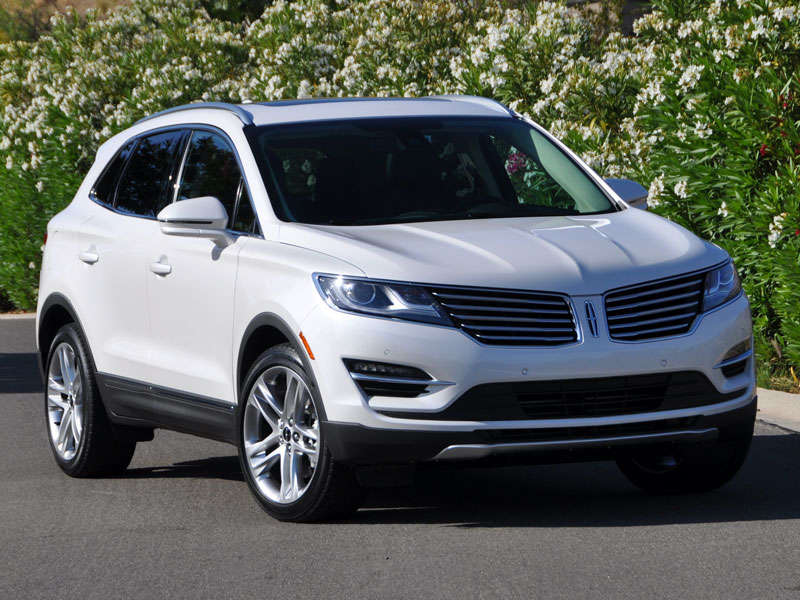
2015 Lincoln MKC Reserve Package White Platinum Metallic Tri-coat 19-inch Aluminum Wheels ・ Photo by Christian Wardlaw
The Lincoln Motor Company has nowhere to go but up, and the new 2015 MKC is critical to the automaker’s revitalization plan. Following last year’s launch of the redesigned MKZ midsize luxury sedan, the 2015 Lincoln MKC is a compact luxury crossover SUV aimed straight at established players in a growing segment that includes the Acura RDX, Audi Q5, BMW X3, Cadillac SRX, Infiniti QX50, Lexus NX, Mercedes-Benz GLK Class, and Volvo XC60.
To see if the MKC has what it takes to convince small luxury SUV shoppers to swing by a Lincoln dealership, I headed to Santa Barbara, Calif., for a day that included hundreds of miles as a driver and passenger. As it turns out, the MKC is a well-rounded crossover, one more suited to certain types of driving than others, and to certain types of lifestyles than others.
2015 Lincoln MKC First Drive Review
Pricing for the 2015 Lincoln MKC starts at $33,995, including the $895 destination charge. A 2.0-liter EcoBoost engine is standard, offered with front-wheel or all-wheel drive ($2,495). The more powerful 2.3-liter EcoBoost engine ($1,140) requires AWD.
Buyers can upgrade to a Select Package ($3,230) that adds premium Bridge of Weir Deepsoft leather seats and a steering wheel wrapped in Wollsdorf leather. A 10-way power front passenger’s seat is also part of the Select Package, along with ambient cabin lighting, a cargo cover, a universal garage door opener, an auto-dimming driver’s side mirror, auto-folding side mirrors with LED turn signal indicators, configurable daytime running lights, and an upgraded wheel finish. The Select Plus Package ($1,100) installs a navigation system and a blind-spot information system with rear cross-traffic alert. Choose the Reserve Package ($6,935) for Select and Select Plus equipment in addition to the following features: heated and ventilated front seats, a panoramic Vista Roof sunroof, a hands-free power-opening liftgate, and polished 18-inch aluminum wheels.
Lincoln also offers a Class II Trailer Tow Package ($495), a Climate Package ($580 – heated rear seats, heated steering wheel, automatic high-beam headlights, rain-sensing wipers), and a Technology Package ($2,235 – Adaptive Cruise Control with Collision Warning, a Forward Sensing System, Active Park Assist, Lane Keeping System). Individual options include a continuously controlled damping suspension ($650), a THX II Certified Audio System ($995), 19-inch wheels ($395), 20-inch wheels ($995), and upgraded paint ($495 to $695).
My Lincoln MKC had the Reserve Package, extra-cost White Platinum Metallic Tri-Coat paint, the more powerful EcoBoost engine with AWD, and most of the options, for a total of $49,465.
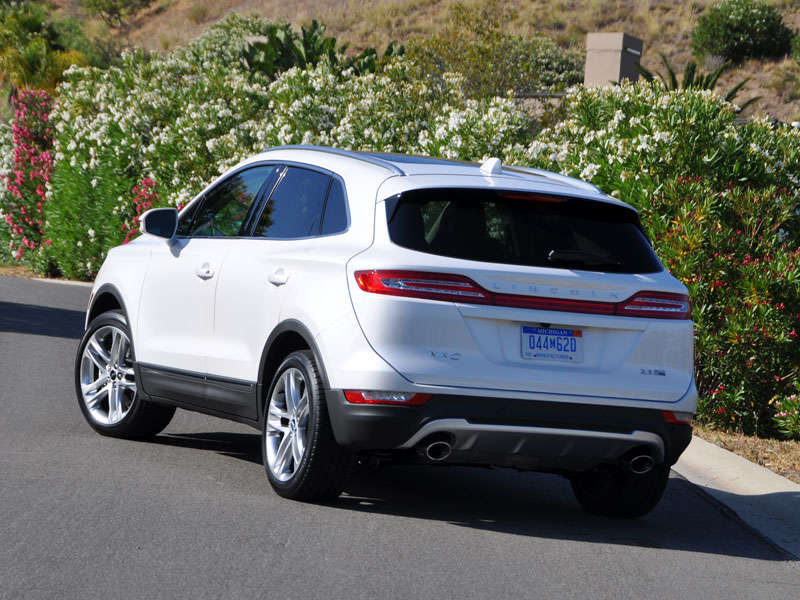
Photo by Christian Wardlaw
2015 Lincoln MKC First Drive Review
Though Lincoln bases the 2015 MKC on the same platform as the Ford Escape, you’d have a hard time telling it. Aside from wheelbase, rear seat legroom, and shoulder room measurements, the Lincoln is different from the Ford thanks to its distinctive styling, premium cabin and noise suppression materials, upgraded engineering details, and broader array of technologies. Before adding options, the Lincoln is actually less expensive than a loaded Ford Escape Titanium. Equivalently equipped, however, the MKC commands a premium of about $6,000.
What do you get in exchange for the extra six grand? Appealing design, for starters. The new Lincoln MKC is good looking, distinctive without resorting to flamboyance, standing clearly apart from its competitors in a subtle and tasteful way entirely in keeping with Lincoln’s developing brand character.
The interior represents a dramatic upgrade, too, with lots of soft-touch materials, available premium leather, and genuine aluminum or matte-finish wood trim. Plus, thanks to Active Noise Cancellation and an acoustic laminated windshield, the Lincoln is much, much quieter inside than the Ford.
Take a look at the MKC’s center console, and you’ll notice that Lincoln is returning traditional stereo power, volume, and tuning knobs to the dashboard, along with buttons and rocker switches for the climate control system. That means you no longer need to use the MyFord Touch infotainment system to control these systems, and it also means that the touchscreen will collect fewer fingerprints and smudges. By the way, be sure to opt for the THX II Certified audio system if you love music, because it sounds terrific.
Where Lincoln departs from tradition is with regard to transmission shifting. Rather than install a shift lever on the MKC’s center console, Lincoln supplies shift buttons stacked in a column along the left side of the MyFord Touch screen. Steering wheel paddle shifters provide manual control over gear changes, and if you forget to choose Park before pushing the engine’s off button, the transmission automatically defaults to that setting.
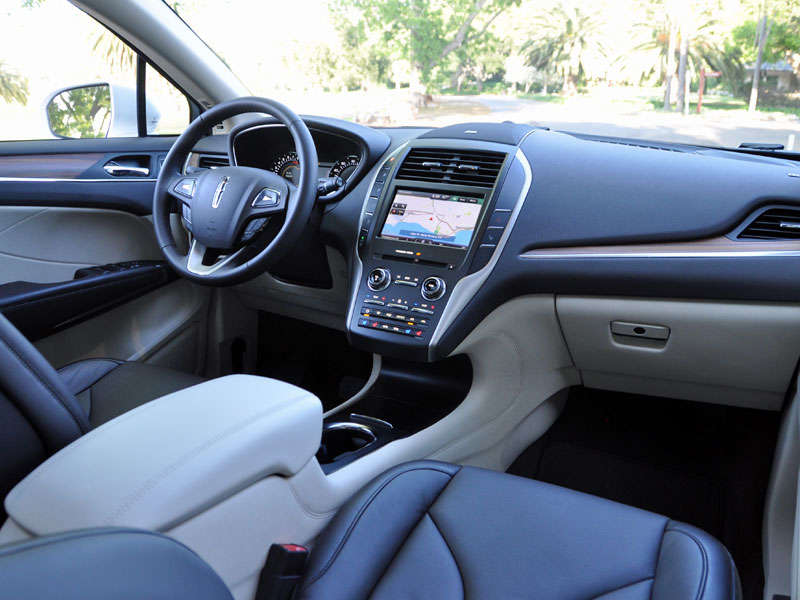
Photo by Christian Wardlaw
2015 Lincoln MKC First Drive Review
Keeping in mind that the Lincoln MKC is a compact crossover SUV, the interior is not what one might describe as roomy. In fact, from a passenger comfort perspective, this is now the smallest Lincoln you can buy.
The front seats are comfortable, my test vehicle’s chairs wrapped in plush Bridge of Weir leather and equipped with heating and ventilation. Lincoln also thoughtfully pads the dashboard and door panels where legs might come into contact with the cabin, improving comfort levels. If there’s anything to complain about, it’s that the seats lack lateral support and larger people might find the bottom cushions to be too small.
The driver and front passenger can choose to sit up high and enjoy an impressive view out. Huge pedestal-style side mirrors provide a terrific view of traffic in adjacent lanes, and the shape of the rear quarter side windows makes it easier to reverse from slanted parking spaces and to see cross-traffic when negotiating X-shaped intersections. The optional panoramic sunroof’s opening is fairly large, yet produces remarkably little noise or wind buffeting. As a result, you might actually want to use it.
If you’ve got children or grandchildren, or you carry passengers on a regular basis, the MKC’s rear seat accommodations are going to disappoint. Adults are likely to find it cramped unless shorter people are riding up front. For reference, I’m six feet tall, and with the driver’s seat set to my preference I had trouble fitting into the back seat, my shins pressing uncomfortably into the softly padded lower portion of the front seat back. Making matters worse, the rear seat position is low, the short bottom cushions lack thigh support, and I had a tough time extricating my size-12 feet in order to exit the SUV. Fold the rear center armrest down, and it is essentially a cup holder rather than a comfortable spot to rest an elbow.
Moms and dads with babies on the way should cross the MKC off the shopping list. There’s really not much chance of getting a reverse-facing child seat into this vehicle, and the 25.2 cubic-foot trunk is narrow with enclosed sides. My bet is that it’s also going to be tough to get a compact stroller into this SUV, let alone a full-size version. You could fold the rear seats down for 53.1 cu.-ft. of room, but then where would the kid go?
You can, however, load the MKC’s cargo area when your hands are full, thanks to the optional hands-free tailgate. Make sure you’re not standing on an icy spot, wave your foot under the rear bumper, and as long as you’ve got the key fob in your pocket or purse, it will power open. The fob also activates the MKC’s Approach Detection system, which illuminates various lighting elements to welcome the driver as he or she approaches, a small but thoughtful gesture that owners are sure to appreciate.
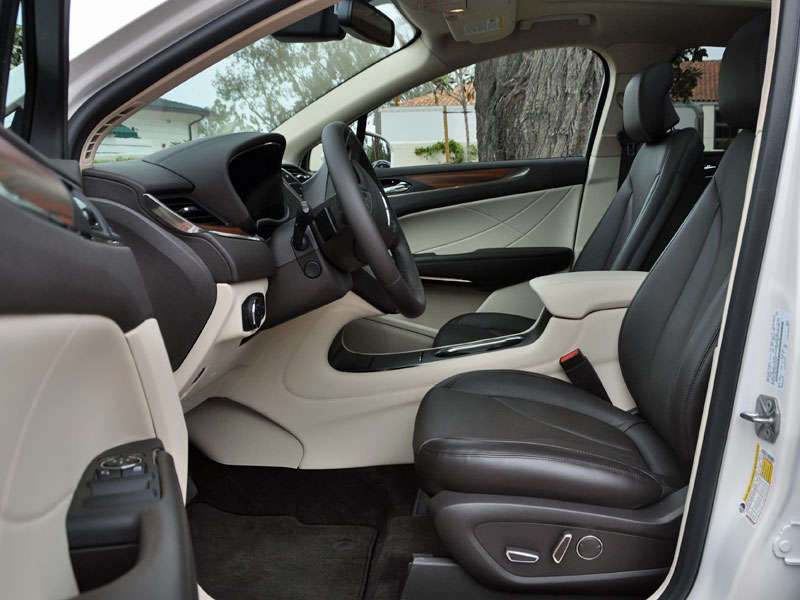
Photo by Christian Wardlaw
2015 Lincoln MKC First Drive Review
Every 2015 Lincoln MKC is equipped with Sync Services technology including 911 Assist. With this system, emergency rescue personnel are dispatched to the MKC’s exact location following an airbag deployment as long as a paired smartphone is aboard the vehicle at the time of the accident.
Optional safety systems include adaptive cruise control with a collision warning system and brake support, a blind-spot information system with rear cross-traffic alert, and a Lane Keeping System. The Lane Keeping System combines lane departure technology that emits a warning vibration through the steering wheel with lane departure prevention technology that adjusts engine torque to try to prevent unintended lane drift if the driver fails to respond to the vibration warning.
In the event that a collision cannot be avoided, Lincoln says it has “crashed and re-crashed” the new MKC 5,000 times using both real and computer-simulated virtual collisions in order to make the SUV as safe as possible. Whether or not the new MKC will improve upon the Ford Escape’s crash-test performance in order to earn a “Top Safety Pick” designation from the Insurance Institute for Highway Safety (IIHS) remains to be seen.
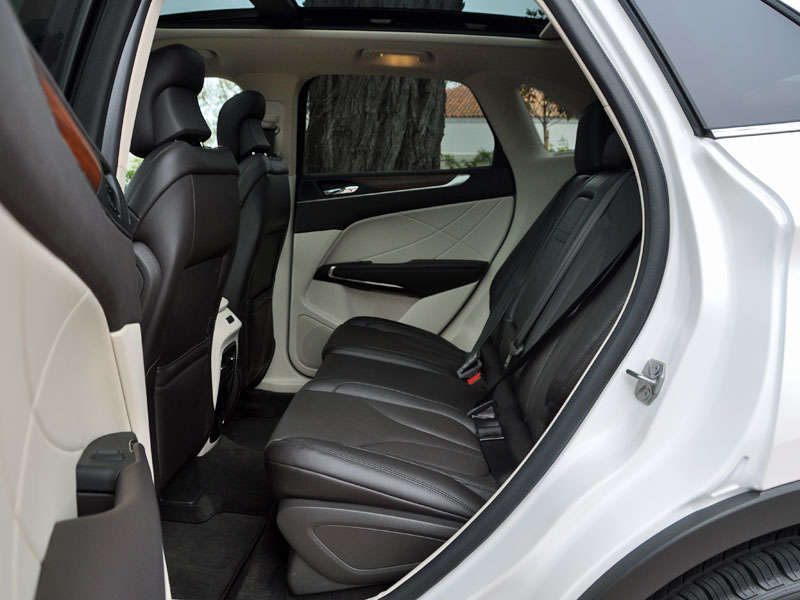
Photo by Christian Wardlaw
2015 Lincoln MKC First Drive Review
Lincoln offers MKC buyers a choice between a turbocharged 2.0-liter 4-cylinder engine and a turbocharged 2.3-liter 4-cylinder engine. All-wheel drive is optional with the smaller EcoBoost engine, and comes standard with the larger EcoBoost engine.
The standard engine is rated to make 240 horsepower at 5,500 rpm and 270 lb.-ft. of torque at 3,000 rpm. Upgrade to the new 2.3-liter EcoBoost engine to enjoy 285 horsepower at 5,500 rpm and 305 lb.-ft. at 2,750 rpm. Lincoln says the majority of each engine’s torque is available across a broad portion of the rev range, helping to make the MKC feel particularly responsive from just about any speed, and that the larger engine features a twin-scroll turbocharger in order to eliminate turbo lag.
Each engine is paired with a 6-speed automatic transmission, and depending on the powertrain configuration, the EPA says the MKC will return between 18 mpg in the city and 29 mpg on the highway. My test vehicle, equipped with the larger EcoBoost engine and AWD, averaged 19.9 mpg over the course of hundreds of miles of driving, coming in a little under its combined driving rating of 21 mpg.
When the MKC is fitted with the optional continuously controlled damping suspension, Lincoln Drive Control allows the driver to calibrate the SUV to Comfort, Normal, and Sport settings, each adjusting the steering, powertrain, ride and handling characteristics accordingly.
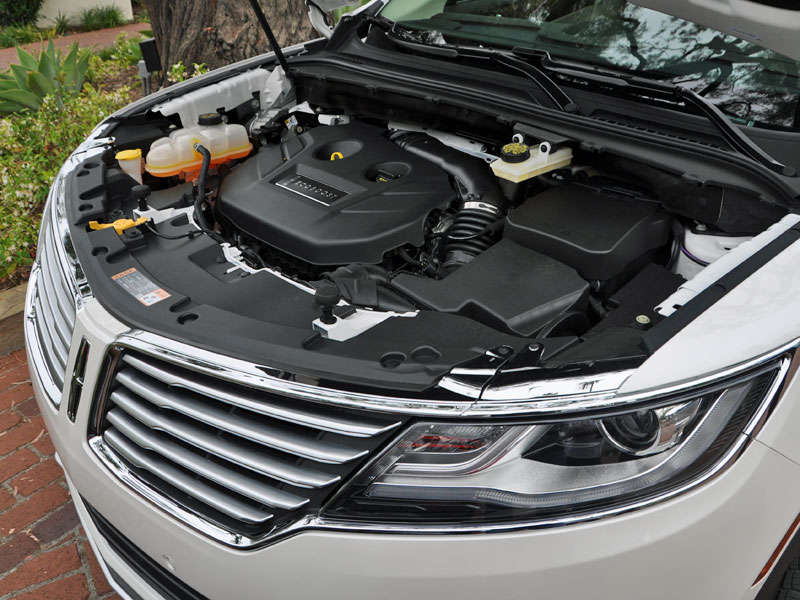
Photo by Christian Wardlaw
2015 Lincoln MKC First Drive Review
Lincoln put us on some spectacular California roads during the MKC’s introduction, few of which showcased the SUV’s real-world dynamic strengths. What I learned on these twisty, mountainous roads is that when Lincoln Drive Control is set to Sport, the MKC’s ride quality is choppy, jittery, and brittle unless the pavement is nice and smooth. Switch to Comfort and the MKC adopts a softer, wallowing, and woozy ride. Either way, it feels like the MKC’s body never stops moving, which I why the Normal setting was my favorite.
No matter which Lincoln Drive Control setting I chose, the MKC’s electric steering felt perfectly natural. The steering wheel is small in terms of diameter, though, and the dry skin on my hands proved incompatible with the smooth and slippery Wollsdorf leather wrapped around the rim. Though the SUV feels a little tall and tippy from the driver’s seat, it nevertheless bends into a curve in predictable, eager fashion, gently rolling weight onto the outside front tire as the driver enters a corner.
The MKC’s optional 19-inch wheels and 245/45 tires offered decent grip and plenty of communication about the road surface, as well as lots of road noise on coarse pavement. Across one wind-blown valley floor with older pavement, the combination of road and wind noise was quite high at speeds over 70 mph.
Ascending several thousand feet in elevation, the MKC’s 2.3-liter EcoBoost engine provided plenty of power across the majority of its rev range, shrugging off the weakening effects of altitude thanks to its twin-scroll turbocharger. With the transmission in Drive mode, slow and delayed downshifts caused some aggravation, but choosing the Sport button or using the paddle shifters on the steering wheel resolved it. When in Sport mode, the transmission shifts crisply and holds gears longer, making the MKC feel more responsive. Coming down the back side of a mountain range, the brakes responded almost too quickly to driver input, and I thought the pedal was positioned too high and little too close to the driver.
Halfway through the driving day, in order to find out how the MKC will serve owners in the real world, I ditched the planned drive route and returned to Santa Barbara using arrow-straight country highways, multi-lane freeways, and suburban boulevards. Here, the MKC proved mighty appealing, always quiet, always composed, and easy to whip into a parking space thanks to its small size. I even liked how the Lincoln Drive Control system’s Comfort setting soaked up the cracks, potholes, and patched pavement scarring the truck-pummeled right lanes of Interstate 5.
In everyday driving situations, the 2.3-liter EcoBoost engine effortlessly merges onto freeways, and responds immediately when a traffic light turns green or you’re making a left turn across traffic. I also tried using the MKC’s Active Park Assist with Park Out Assist, which steers the SUV into and out of parallel parking spaces. It works well, and if you’re terrible at putting a car against a curb, you’ll probably appreciate using this system.
Though the MKC is genuinely athletic on twisty roads, it is clearly better suited to daily-driving situations, where the tall driving position doesn’t make the SUV feel like it’s on tippy-toes, where the powertrain delivers effortless performance, where Lincoln Drive Control proves more useful, and where its compact dimensions make life easier. I still wished for power adjustable pedals, though.
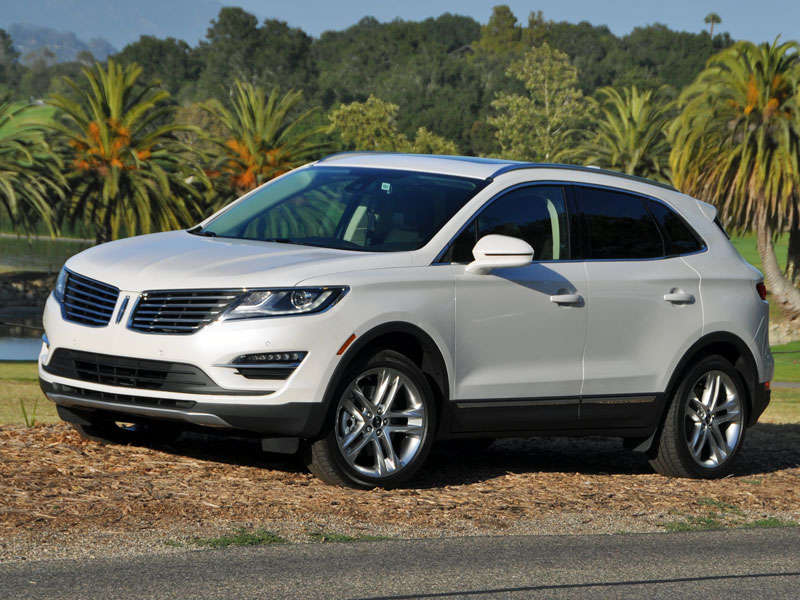
Photo by Christian Wardlaw
2015 Lincoln MKC First Drive Review
Oozing style and sophistication, the 2015 Lincoln MKC strikes me as best suited to empty-nest couples who will only occasionally use the back seat. A perfect reward after the kids have left the house and the college tuition bills are paid, a Lincoln MKC serves as a compelling foul-weather friend and cross-country tourer that blends luxury and practicality in an appealing package.
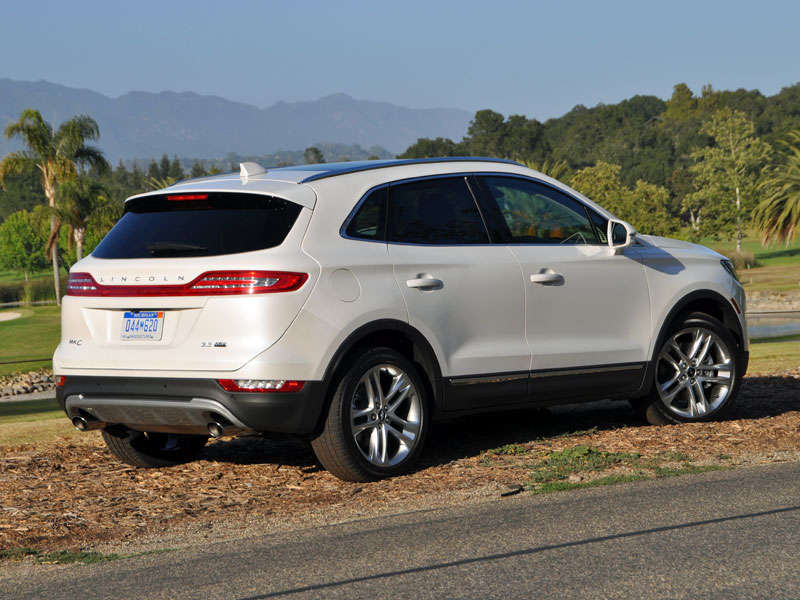
Photo by Christian Wardlaw